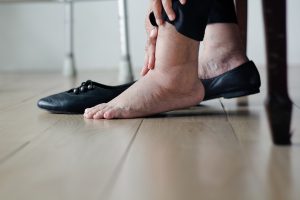December 27, 2023
If you’ve been diagnosed with type 1 or type 2 diabetes, keeping your feet healthy is as important as keeping your blood sugar levels in check. That’s because diabetes causes poor blood flow and increases your risk of developing nerve damage. This can lead to swelling, the inability to feel your feet, and other foot-related problems.
According to Cleveland Clinic, “the chance that a person with diabetes will develop a foot condition at some time in their life is about 15%.”
Healthcare Associates of Texas cares about you and your health. As soon as you notice that your feet are swollen, follow these proven steps to relieve the swelling.
Why does foot swelling from diabetes happen?
Feet swelling diabetes issues happen on account of reduced blood flow. When your lower extremities don’t receive as much blood as they require, your blood vessels can sustain damage over time. This could result in a diagnosis of Peripheral Artery Disease (PAD) or diabetic neuropathy. These conditions indicate that your blood vessels aren’t functioning as well as they should be.
Type 1 and type 2 diabetes are also diseases that are associated with chronic inflammation. Chronic inflammation triggers fluid retention and increases the frequency of foot swelling.
The National Institute of Diabetes and Digestive and Kidney Diseases (NIH) emphasizes the need to wash your feet every day and closely examine them for signs of swelling as well as wounds, ingrown toenails, plantar warts, and other issues that can cause problems if left untreated.
Stopping diabetes feet swelling
Here are 12 ways to stop diabetic feet swelling that you can do in the comfort of your own home:
1. Elevate your feet
Elevating your feet stops blood from gathering in your legs and pushes the blood back toward your heart. You can elevate your feet by lying in bed or sitting on the couch. Use an ottoman, stool, cushions, or pillows to help get your feet as high above your heart level as possible.
 2. Drink plenty of fluids
2. Drink plenty of fluids
The more water you can drink throughout the day, the better—especially when your feet are swollen. Regular fluid intake ensures that you will not become dehydrated. Dehydration tends to make diabetes feet swelling worse.
3. Wear compression stockings
Think of compression stockings as socks that gently squeeze your feet. The goal is to promote better circulation in your lower legs. This reduces feet swelling diabetes symptoms and keeps the ideal amount of pressure in your feet and lower legs.
4. Limit your salt intake
If your feet are swollen, avoid salty foods as much as you can. Low-sodium foods and foods labeled “no salt added” are good choices. Foods containing too much sodium can potentially make feet swelling issues more prevalent.
5. Go for short, frequent walks
Take a break from elevating your feet and go for a short walk. Getting up and walking around at least once or twice every hour can improve blood flow.
 6. Soak your feet in Epsom salts
6. Soak your feet in Epsom salts
Epsom salt soaks work well for swollen feet. Fill a footbath or a bathtub with water and then add Epsom salts. Soak your feet for up to 20 minutes to alleviate pain.
7. Quit smoking
If you smoke and your feet are swollen, consider quitting or, at the very least, limit your tobacco intake as much as possible. Nicotine damages your blood vessels and weakens blood circulation. This can make it more challenging to treat diabetic feet swelling.
8. Get a foot massage
A foot massage will improve blood flow in your feet, making this a great way to combat diabetic feet swelling. If you are unable to give yourself a foot massage, ask a family member or friend to give you one. Be sure to avoid massaging areas that have a visible cut or open wound.
9. Consider magnesium supplements
Speak to your trusted healthcare provider about the possibility of taking magnesium supplements to stop diabetes feet swelling. Magnesium supports blood sugar levels and regulates nerve function. If your body isn’t getting enough of this essential nutrient, your doctor may recommend these supplements to correct the deficiency. If your doctor does not recommend magnesium supplements, ask about magnesium-rich foods you could add to your diet such as quinoa, cashews, and spinach.
 10. Wear shoes that fit well
10. Wear shoes that fit well
There might be a connection between feet swelling, diabetes, and the shoes you wear outside of the house. If your shoes are too tight, your feet may swell more often because your blood vessels are too restricted. Assess the shoes you wear so you can be certain that they aren’t contributing to diabetes feet swelling.
11. Take all medications as prescribed
You can stop diabetic feet swelling by taking your diabetes medications as prescribed. Medications that regulate blood sugar levels reduce the risk of swelling. Missing a dose or taking less than prescribed is not advisable.
12. Manage your weight
A good long-term solution for stopping feet swelling from diabetes is to manage your weight. Excess weight puts extra pressure on your feet, which can intensify diabetes feet swelling. Talk to your doctor about the lifestyle changes you can make so you can take another proactive step toward stopping—and preventing—swollen feet.
Diabetic feet swelling in type 1 and type 2 diabetes
Type 1 diabetes is an autoimmune disease; it occurs when your immune system attacks your pancreas, the organ in your body that makes insulin. type 1 diabetes is usually genetic.
Type 2 diabetes occurs when your body becomes resistant to insulin, and you have elevated levels of glucose in your blood. Type 2 diabetes can occur among obese individuals as well as those with a genetic predisposition.
Diabetic foot swelling is a common concern among individuals with type 1 and type 2 diabetes. It’s important to note, however, that the frequency of feet swelling and the treatment in each diabetes type for feet swelling may differ. Your doctor’s personalized approach depends on the type of diabetes you have, the frequency and severity of the swelling you experience, and your daily foot care routine.
Whether you have type 1 or type 2 diabetes, the 12 ways to stop feet swelling that we’ve shared can benefit you and promote the health of your feet now and in the future.
 Diabetic feet swelling: When to see a doctor
Diabetic feet swelling: When to see a doctor
If your type 1 or type 2 diabetes has caused nerve damage, it’s important to pay close attention to your feet. Sometimes swelling can be a sign of an infection. You may, for instance, have a cut or other wound that has become infected without you even noticing. In this case, you’ll need to seek medical attention right away. Cuts, sores, blisters, and other skin issues that appear on your feet that have not healed properly due to the decreased blood flow is a scary situation. In a worst-case scenario, a surgeon might have to amputate one or more toes, your foot, or your leg.
If you try one or more of these 12 ways to stop feet swelling and the swelling hasn’t decreased, call or visit your doctor. Depending on the severity and duration of your swelling—as well as whether you have type 1 or type 2 diabetes—your doctor will recommend the next steps you should take. You may, for example, need to have your medications adjusted or undergo testing to determine if you have diabetic neuropathy or another condition commonly associated with diabetes.
Visit Healthcare Associates of Texas for all your medical needs
If you have diabetes, foot swelling is a common issue that should be addressed for your health, safety, and comfort.
At Healthcare Associates of Texas, we invite you to visit one of our convenient locations. We prioritize your health and tailor our treatment methods to meet your needs and relieve your symptoms. We’re proud to provide a total continuum of care by offering comprehensive family medicine and ancillary services across the state of Texas.
By placing your trust in Healthcare Associates of Texas, you can rest assured that you’ll be treated with the utmost care and respect and that we’ll give you the time, care, and attention you deserve.
Book an appointment today if you have diabetes feet swelling or any other medical issue that we can accurately diagnose and promptly treat. Our team of board-certified physicians, certified Physician Assistants, and Nurse Practitioners look forward to serving you.
References
- Cleveland Clinic. (n.d.). Diabetes-Related Foot Conditions. Cleveland Clinic. https://my.clevelandclinic.org/health/diseases/21510-diabetic-feet
- National Institute of Diabetes and Digestive and Kidney Diseases. (n.d.). Diabetes & Foot Problems. National Institute of Diabetes and Digestive and Kidney Diseases. https://www.niddk.nih.gov/health-information/diabetes/overview/preventing-problems/foot-problems
DISCLAIMER
The information featured in this site is general in nature. The site provides health information designed to complement your personal health management. It does not provide medical advice or health services and is not meant to replace professional advice or imply coverage of specific clinical services or products. The inclusion of links to other web sites does not imply any endorsement of the material on such websites.
Ready to become your healthiest self?
Get tips delivered to your e-mail inbox every month. Let’s get happier and healthier together!



